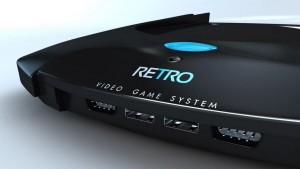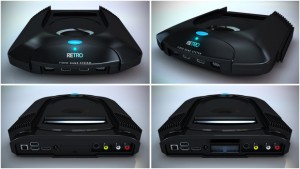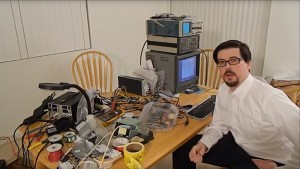The Coleco Chameleon Catastrophe
This Atari Jaguar plastic shell simply cannot catch a break. This poor thing has the dubious honor of being attached to nothing but commercial failure and odd business dealings. It housed the aptly titled and ill-fated Atari Jaguar, marking the very last time a home video game console would be engineered and manufactured in the good old USA.

The molds for the housing were later exhumed from the Atari catacombs and sold to a dental equipment company. The Imagen Systems Corporation took the molds to make an oral camera device called the Imagen HotRod; this is indeed a thing that exists. Now this case design has found itself knee-deep in quite the controversial debacle involving the Coleco Chameleon.
Originally dubbed the Retro VGS (Video Game System), this new console was spearheaded by the Retro Video Games Inc. founded by Mike Kennedy. Apparently, he and his team had acquired the molds for the sake of saving money in producing housing for their proposed console. There was an IndieGoGo campaign held to raise funds to start creating the console and offered different rewards consisting of different color shells for the system. The initial pitch of the Retro was that it would be a brand new cartridge-based game console that would not be crippled by the things that sometimes plague modern consoles. It would also be an all-in-one system that would run games from several preexisting cartridge systems like the NES, Super NES, Genesis and so on. This would have been achieved through hardware containing several field-programmable gate arrays or FPGAs containing emulated cores for each supported system as well as a physical adapter to allow connectivity between the game cartridge and the console.

Unsavory things like broken games, constant patch updates and DLC would not be an issue with this platform. It would function in the same way that the classic fourth and fifth generation system would; you would have to buy the hardware and the games and it would just run. The games would have been made by homebrew and independent developers like. This initial dream sound like a great idea on paper, as there are some solid developers doing amazing things on older systems that are no longer supported. Pier Solar from Watermelon Games and titles from Collectorvision Games being made for older legacy systems like the Sega Dreamcast and Genesis are examples of how new life can be breathed into such non-supported systems.
It is an interesting idea from the outset and the Retro VGS team was attempting to capitalize on this nostalgia. This prompted the company to start an IndieGoGo back in September of last last year and the goal for it was $1,950,000 in order to get the project on wheels. While there were some folks who offered financial and verbal support for this new old console, others raised rather legitimate criticisms pertaining to the original concept and campaign.
The first issue was that the Retro VGS team had no working prototype of the console in question. The RVGS folks probably tried to start a Kickstarter campaign, but that platform requires a fully working prototype in order to start one. IndieGoGo is simply not as big and/or legitimate a platform for crowd funding as Kickstarter is at this point. Another aspect of the effort that people took issue with was the different tiers of rewards for donating particular amounts of money, which practically changed nothing but the color of the plastic shell that would house the innards of the console.
Another problem had to do with the price, which constantly rose due to all of the features included from both a hardware and software standpoint. The console was originally going to support a multitude of cartridge formats with the aforementioned cores via its FPGAs. This alone requires months upon months of time and effort just to get one core that accurately emulates a system depending on the complexity of that particular system’s architecture. Most of the Retro VGS team consisted of PR and marketing individuals, so the possibility of this being done in a reasonable amount of time would be nigh impossible and cost a lot of money to make it happen.
The console also touted multiple inputs and outputs for peripherals and video connections. On top of the power supply jack, the system allegedly was going to support HDMI, S-video and standard composite video through RCA cables. It was going to also support four USB ports and two nine pin serial ports (for Atari 2600 and Genesis controllers) along with support for special wireless Retro VGS pads. All of these physical ports cost a bit of scratch to include for any video game console. The original PS3 cost an arm and a leg and a lot of it had to due with just how many physical jacks and ports were thrown into the box among other things. Sony eventually learned from this and truncated the hardware by removing those excessive features.
The last issue, as far as price is concerned, has to do with the very idea of releasing games on cartridge. Even today, cartridge-based games cost more money to produce than they are worth. There is a reason why nobody manufactures game cartridges and is the sheer cost alone. Labels and plastic shells have to be printed and molded, programmable chips have to be burned and this means that an entire fabrication facility would have to be built to cater to this endeavor.
This also affects the software end as well. If one releases a game on cartridge, the game has to be bug-free before it ships. You would hypothetically need a large team of QA testers just for one title. Again, the staff of the original team would not have been conducive to fully testing all the supported RVGS games for launch. With all of these issues taken into account, it is no mystery why the system was projected to cost $299 without even knowing how much the physical games would cost. The folks over at the Atari Age forums and retro gaming personalities including Pat Contri (a.k.a. Pat the NES Punk) put a lot of spotlight on these problems. Many skeptics and retro gamers were rightfully concerned with this console that, at the time of the campaign, did not even have a simple working prototype. It was simply an idea with hardly any meaningful manpower behind it.
With that, it is no surprise that the IndieGoGo campaign failed, only accruing $81,158 of its original $1,950,000 goal. However, the Retro VGS team did not stop there. The project went dormant for some time and eventually reemerged as the Coleco Chameleon. The team, or Mike Kennedy, had purchased the rights to use the Coleco name from the company Coleco Holdings for the system. The name of the box might have changed, but the original concept had not.
This came to a head at the American International Toy Fair in New York during February earlier this year in which Kennedy showed off a prototype of the Chameleon in his booth. There were quite a few articles and videos published around this time that essentially gave positive coverage on the system across Gizmodo, Techno Buffalo, Engadget, SEO Toy Review and a few other such publications. Unfortunately for these outlets, they never did any investigative work past regurgitating PR information from the Chameleon team and Mike Kennedy.
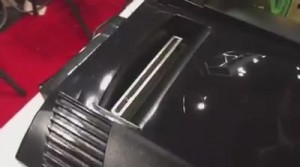
There were many red flags that stemmed from this showcase at the Toy Fair that pointed to a disgusting truth – the Coleco Chameleon prototype was faked. Firstly, the system was only running SNES games. This alone could have been simply written off by explaining that only the SNES core had been finished for the console, which is what Kennedy stated at the trade show. The issue with this statement is that, out of all of the systems to create FPGA cores of, the SNES is the most difficult nut to crack. There have been only two known attempts to recreate the SNES on a FPGA chip, with only one of them being relatively successful; ‘relatively’ being the word because said attempt will not properly run any of the Super FX titles. Not only that, but the more successful project required a FPGA chip that, by itself, was more expensive than the projected price of the Chameleon in its final retail package form.
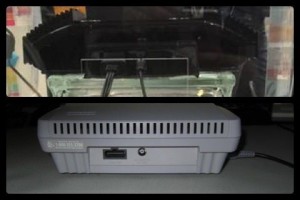
Another element of this demo that was suspect was that the proprietary controller did not work and input was handled via hardwired third-party SNES controllers. The console was in an acrylic case in which the wires for said controllers threaded through. It would be ridiculous to think that the hardware team would have knowingly hardwired those controllers in a way that the case would be permanently attached in such a weird way.
Another red flag was that console, that was originally supposed to support HDMI and standard composite and S-video, only had jacks for power and a curious proprietary Nintendo video out. To add to the suspicion, the spacing between the two ports was exactly the same as that of the second SNES revision dubbed the SNES Jr. That particular part of the console was wrapped in electrical tape for some reason and the prototype’s power LED did not work when power up just like the SNES Jr. Even the cartridge feed had the same form factor as the SNES. Finally, the cartridge being used on the machine, containing multiple SNES titles, looked to use the same wafer board as the same as the SD2SNES flash cartridge.
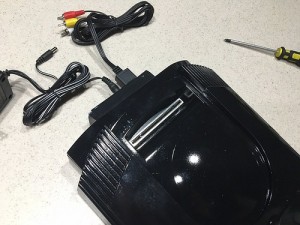
Thanks to the members of Atari Age, theories were presented and physical mock-ups were constructed to deduce what exactly was shown at the Toy Fair. All of this evidence that was plain as day for anyone who looked at the photos taken and the few videos shot points to the fact that the supposed prototype was actually a Super Nintendo mini or Jr. shoved into an Atari Jaguar shell with electrical tape used to obscure any physical resemblance to the true hardware being used.
Roughly half an hour after the most damning photos of the console were used to prove the console was a fraud, they were pulled from the official page. The internet exploded over this with many pointing fingers and others running damage control. Retro Video Game Systems denied that the prototype was a fake and even had the members of Retro Magazine, including then editor-in-chief Dave Giltinan, who defended that the project was on the level. On the other side of things, those who saw the product as a scam kept investigating and asking relevant questions on the Retro VGS Facebook page, only to get banned or have their comments rejected.
On the day that the Kickstarter campaign for the Coleco Chameleon was supposed to commence the team stated that it was being delayed to, “make it even better!” That statement was then followed up with some more photos of a brand new prototype that feature a frosty translucent Jaguar top shell piece which showed a circuit board. It took no longer for the Atari Age community to figure out what exactly was under the hood. Apparently, the board in the case was a PCI DVR capture card for use in a PC. To be specific, it was a HICAP50B CCTV DVR Capture Card that was pushed as being the main board for the system. A mere half hour after the discovery was made, the most revealing photo, like the Toy Fair fiasco, was pulled from the official page.
This was the final straw for many who looked upon this new retro system as being a product of willful deception. With criticism being hurled at multiple targets, Coleco Holdings issued a statement that it will be giving the Retro VGS team an ultimatum. If the company was unable to present a working prototype to Coleco in seven days then it would pull out of the agreement made between both entities. Well, seven days passed and Coleco pulled its name from the project on March 8, 2016 Stating:
“Retro has decided that the work that they have created is not sufficient to demonstrate at this time. Consequently, we can no longer proceed with the project and the Chameleon project will be terminated. This separation is amicable. We wish Retro luck in the future.” – Coleco Holdings
At this point the whole jig was up. In lieu of this parting, key people who associated with the project in some form or another had stepped forward sharing their negative experiences with the Chameleon and more importantly Mike Kennedy. Individuals including John Carlsen (Retro VGS Engineer), John Lester (Gamester81 on YouTube) and Brian Barnhart of the (Jag Bar internet show) and a few others have chimed in about the unmitigated mess that was the Chameleon.
Kennedy was very quick to throw Carlsen under the bus after the IndieGoGo campaign failed. In an interview with Carlsen on Retro Gaming Magazine, Carlsen went on to explain how uninformed and uneducated Kennedy is when it comes to designing, engineering and costing out a piece of home video game hardware. His expectations on the time, money and manpower required to make a system with multiple software-based system cores on an FPGA were completely unrealistic. Adding to this frustration, Kennedy and his partner kept wanting to add features thinking it would not adversely affect the final cost. He was also responsible for the cringe-worthy video that Carsen was forced to upload on Youtube featuring his ‘lab’ showing a prototype of the Retro VGS alongside some equipment.
John Lester, a retrogaming YouTube personality, is another casualty of this whole debacle with his reputation having been questioned by skeptics. He was actually somewhat associated with the Chameleon as a software publisher. He is the owner of Collectorvision Games, a publisher that produces titles for older systems that are no longer officially supported. Because of the controversy and a change in the initial agreement between Collectorvision and Retro Video Game Systems, Lester pulled out of the publishing deal. He came under quite a bit of fire from some over videos in which he interviewed Mike Kennedy about the Chameleon and playfully addressing the critics on Atari Age as ‘haters’, noting the stance against the console in question. Lester has since addressed this and also the fact that Kennedy basically deceived him along with everybody else.
The case with the Jag Bar’s Brian Barnhart is especially interesting because he was originally going to help in producing the call-to-arms sizzle video for the Coleco Chameleon Kickstarter campaign. He actually had Kennedy on an episode of the Jag Bar and did talk with for a length on the Retro VGS, Mike insisted that Brian cut that section from the episode for unknown reasons. After trying thrice to organize a video shoot for the Kickstarter video and seeing the controversy with the Toy Fair plus the DVR card concerned Barnhart. Kennedy then wanted to only shoot his call to arms segment and some voice over without context, which only added to Barnhart’s suspicion. Brian Eventually backed away from the project when Kennedy refused to come on to the Jag Bar to show the prototype.
What may have began as an endeavor filed with good intentions has exponentially devolved into a clear cut case of willful deception and fraud. The members of the Retro Video Game Systems company should consider themselves lucky they were found out by the retro gaming community when they were. If they got to the point where they could get a Kickstarter up and running, the team could have potentially faced legal action. As for Mike Kennedy, he is a pariah, vanishing from the gaming world and the internet for that matter. The official website for the Chameleon is gone and the Facebook page has bee scrubbed from existence. The fallout of this disaster even spread over to Kennedy’s other venture Retro Magazine with Dave Giltinan stepping down as editor-in-chief and leaving the publication.
Hopefully, this serves as a lesson to anyone who plans to capitalize on the nostalgia of retro gaming for all the wrong reasons. The members retro gaming community are an intelligent, inquisitive bunch that are not so easily fooled. The various outlets that did no investigative work in covering the system during the 2016 Toy Fair need to learn from this as well. There is a responsibility to look out for prospective consumers in the gaming world and make sure they are informed with the facts help make educated opinions and decisions. With this catastrophe coming to a close, the irony of the system being called the Chameleon must be noted. The only silver lining to the situation is how fitting this console’s moniker was, as it has mysteriously blended into the background, never to show its true colors ever again.
No related posts.




